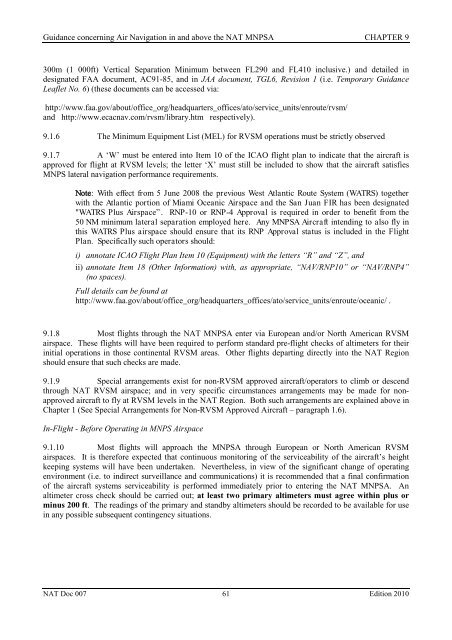World Air Ops | NAT | Doc 007 MNPS Guidance
World Air Ops | NAT | Doc 007 MNPS Guidance
World Air Ops | NAT | Doc 007 MNPS Guidance
Create successful ePaper yourself
Turn your PDF publications into a flip-book with our unique Google optimized e-Paper software.
<strong>Guidance</strong> concerning <strong>Air</strong> Navigation in and above the <strong>NAT</strong> <strong>MNPS</strong>A CHAPTER 9300m (1 000ft) Vertical Separation Minimum between FL290 and FL410 inclusive.) and detailed indesignated FAA document, AC91-85, and in JAA document, TGL6, Revision 1 (i.e. Temporary <strong>Guidance</strong>Leaflet No. 6) (these documents can be accessed via:http://www.faa.gov/about/office_org/headquarters_offices/ato/service_units/enroute/rvsm/and http://www.ecacnav.com/rvsm/library.htm respectively).9.1.6 The Minimum Equipment List (MEL) for RVSM operations must be strictly observed9.1.7 A ‘W’ must be entered into Item 10 of the ICAO flight plan to indicate that the aircraft isapproved for flight at RVSM levels; the letter ‘X’ must still be included to show that the aircraft satisfies<strong>MNPS</strong> lateral navigation performance requirements.Note: With effect from 5 June 2008 the previous West Atlantic Route System (WATRS) togetherwith the Atlantic portion of Miami Oceanic <strong>Air</strong>space and the San Juan FIR has been designated"WATRS Plus <strong>Air</strong>space”. RNP-10 or RNP-4 Approval is required in order to benefit from the50 NM minimum lateral separation employed here. Any <strong>MNPS</strong>A <strong>Air</strong>craft intending to also fly inthis WATRS Plus airspace should ensure that its RNP Approval status is included in the FlightPlan. Specifically such operators should:i) annotate ICAO Flight Plan Item 10 (Equipment) with the letters “R” and “Z”, andii) annotate Item 18 (Other Information) with, as appropriate, “NAV/RNP10” or “NAV/RNP4”(no spaces).Full details can be found athttp://www.faa.gov/about/office_org/headquarters_offices/ato/service_units/enroute/oceanic/ .9.1.8 Most flights through the <strong>NAT</strong> <strong>MNPS</strong>A enter via European and/or North American RVSMairspace. These flights will have been required to perform standard pre-flight checks of altimeters for theirinitial operations in those continental RVSM areas. Other flights departing directly into the <strong>NAT</strong> Regionshould ensure that such checks are made.9.1.9 Special arrangements exist for non-RVSM approved aircraft/operators to climb or descendthrough <strong>NAT</strong> RVSM airspace; and in very specific circumstances arrangements may be made for nonapprovedaircraft to fly at RVSM levels in the <strong>NAT</strong> Region. Both such arrangements are explained above inChapter 1 (See Special Arrangements for Non-RVSM Approved <strong>Air</strong>craft – paragraph 1.6).In-Flight - Before Operating in <strong>MNPS</strong> <strong>Air</strong>space9.1.10 Most flights will approach the <strong>MNPS</strong>A through European or North American RVSMairspaces. It is therefore expected that continuous monitoring of the serviceability of the aircraft’s heightkeeping systems will have been undertaken. Nevertheless, in view of the significant change of operatingenvironment (i.e. to indirect surveillance and communications) it is recommended that a final confirmationof the aircraft systems serviceability is performed immediately prior to entering the <strong>NAT</strong> <strong>MNPS</strong>A. Analtimeter cross check should be carried out; at least two primary altimeters must agree within plus orminus 200 ft. The readings of the primary and standby altimeters should be recorded to be available for usein any possible subsequent contingency situations.<strong>NAT</strong> <strong>Doc</strong> <strong>007</strong> 61 Edition 2010
















